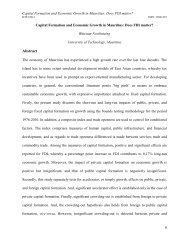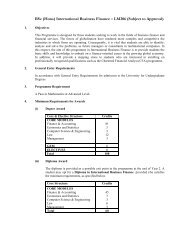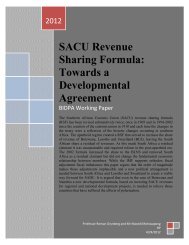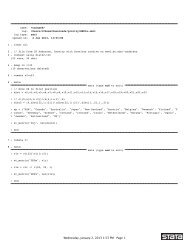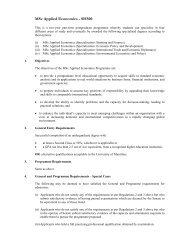A Theoretical Foundation for the Gravity Equation
A Theoretical Foundation for the Gravity Equation
A Theoretical Foundation for the Gravity Equation
You also want an ePaper? Increase the reach of your titles
YUMPU automatically turns print PDFs into web optimized ePapers that Google loves.
A <strong>Theoretical</strong> <strong>Foundation</strong> <strong>for</strong> <strong>the</strong> <strong>Gravity</strong> <strong>Equation</strong><br />
By JAMES<br />
E. ANDERSON*<br />
Probably <strong>the</strong> most successful empirical<br />
trade device of <strong>the</strong> last twenty-five years is<br />
<strong>the</strong> gravity equation. Applied to a wide<br />
variety of goods and factors moving over<br />
regional and national borders under differing<br />
circumstances, it usually produces a<br />
good fit. Un<strong>for</strong>tunately, as is widely recognized,<br />
its use <strong>for</strong> policy is severely hampered<br />
by its "unidentified" properties.<br />
Insertion into <strong>the</strong> equation of policy instruments<br />
such as border taxes has no<br />
<strong>the</strong>oretical justification; and inference<br />
about <strong>the</strong> effect of taxes from examining<br />
changes in <strong>the</strong> equation over times when<br />
taxes have changed carries no guarantee of<br />
validity.<br />
The gravity equation ordinarily is specified<br />
as<br />
(1) Mijk = ak YI k y7kN kNjkd A,k Uijk<br />
where Mijk is <strong>the</strong> dollar flow of good or<br />
factor k from country or region i to country<br />
or region j, Yi and Yj are incomes in i and j,<br />
Ni and Nj are population in i and j, and d1j<br />
is <strong>the</strong> distance between countries (regions)<br />
i andj. The Uijk is a lognormally distributed<br />
error term with E(In Uijk) = 0. Frequently<br />
<strong>the</strong> flows are aggregated across goods.<br />
Ordinarily <strong>the</strong> equation is run on crosssection<br />
data and sometimes on pooled data.<br />
Typical estimates find income elasticities<br />
not significantly different from one and<br />
significantly different from zero, and population<br />
elasticities around -.4 usually significantly<br />
different from zero.'<br />
The intent of this paper is to provide a<br />
<strong>the</strong>oretical explanation <strong>for</strong> <strong>the</strong> gravity<br />
equation applied to commodities. It uses<br />
<strong>the</strong> properties of expenditure systems with<br />
a maintained hypo<strong>the</strong>sis of identical homo<strong>the</strong>tic<br />
preferences across regions. Products<br />
are differentiated by place of origin (<strong>for</strong><br />
*Professor of economics, Boston College. I am indebted<br />
to Marvin Kraus and Edward Leamer <strong>for</strong><br />
helpful comments.<br />
1 See <strong>for</strong> example Norman D. Aitken.<br />
106<br />
a justification, see Peter Isard). The gravity<br />
model constrains <strong>the</strong> pure expenditure system<br />
by specifying that <strong>the</strong> share of national<br />
expenditure accounted <strong>for</strong> by spending<br />
on tradeables (openness to trade) is a<br />
stable unidentified reduced-<strong>for</strong>m function<br />
of income and population. The share of<br />
total tradeable goods expenditure accounted<br />
<strong>for</strong> by each tradeable good category<br />
across regions is an identified (through<br />
preferences) function of transit cost variables.<br />
Partial identification is achieved.<br />
While o<strong>the</strong>r interpretations are possible<br />
(see <strong>for</strong> example Edward Leamer and<br />
Robert Stern),2 <strong>the</strong> one advanced here has<br />
2They offer three explanations. The first, based on<br />
physics, has little interest. The second identifies <strong>the</strong><br />
equation loosely as a reduced <strong>for</strong>m with exogenous<br />
demand-side variables (importer income and population)<br />
and supply-side variables (exporter income and<br />
population). Alternatively, <strong>the</strong> importer and exporter<br />
characteristics identify <strong>the</strong> size of <strong>the</strong> <strong>for</strong>eign<br />
sector in each, with any flow a function of size at ei<strong>the</strong>r<br />
end. The third interpretation is based on a probability<br />
model. Let Zi be country i's total imports, an unidentified<br />
reduced-<strong>for</strong>m function of income, population,<br />
and o<strong>the</strong>r possibly unobservable variables. The set<br />
IZil/T, where T = ,Z,, world trade, has <strong>the</strong> <strong>for</strong>m of<br />
a probability distribution. Alternatively Zi/T is a<br />
trade potential. The probability of <strong>the</strong> occurrence of<br />
flow between i and j is taken to be ZiZj/T2. Alternatively,<br />
potential between i and ] is <strong>the</strong> product of <strong>the</strong> i<br />
and j potentials. The expected size of <strong>the</strong> flow given<br />
T is <strong>the</strong>n Mii<br />
= ZiZj/T. The term T is constant in a<br />
cross-section study and can be neglected. Resistance<br />
to trade, proxied by distance, can be inserted and with<br />
<strong>the</strong> log-linear <strong>for</strong>m <strong>for</strong> all functions, we have <strong>the</strong><br />
gravity equation. This interpretation has <strong>the</strong> advantage<br />
of explaining <strong>the</strong> multiplicative functional <strong>for</strong>m, and<br />
has a useful flexibility. Leamer subsequently developed<br />
a hybrid version of it to explain aggregate imports of<br />
good k by country i. In <strong>the</strong> hybrid model, Zj becomes<br />
Zj(i) = 2jsiZj. Also, <strong>the</strong> parameters of <strong>the</strong> Zi and<br />
Zj(i) functions are permitted to vary by commodity<br />
group k. Leamer's hybrid is thus<br />
M1k = Zi Zj(i) 'I(di, ti, tj(j))<br />
where di is a vector of distance from i to all o<strong>the</strong>r<br />
countries, ti is a vector of i's tariffs, and tj(i) is a vector<br />
of all o<strong>the</strong>r countries' tariffs. The problem with<br />
ei<strong>the</strong>r <strong>the</strong> Leamer-Stern gravity interpretation or <strong>the</strong><br />
Leamer hybrid is that while <strong>the</strong> potential or probabil-<br />
This content downloaded on Thu, 3 Jan 2013 15:32:06 PM<br />
All use subject to JSTOR Terms and Conditions




